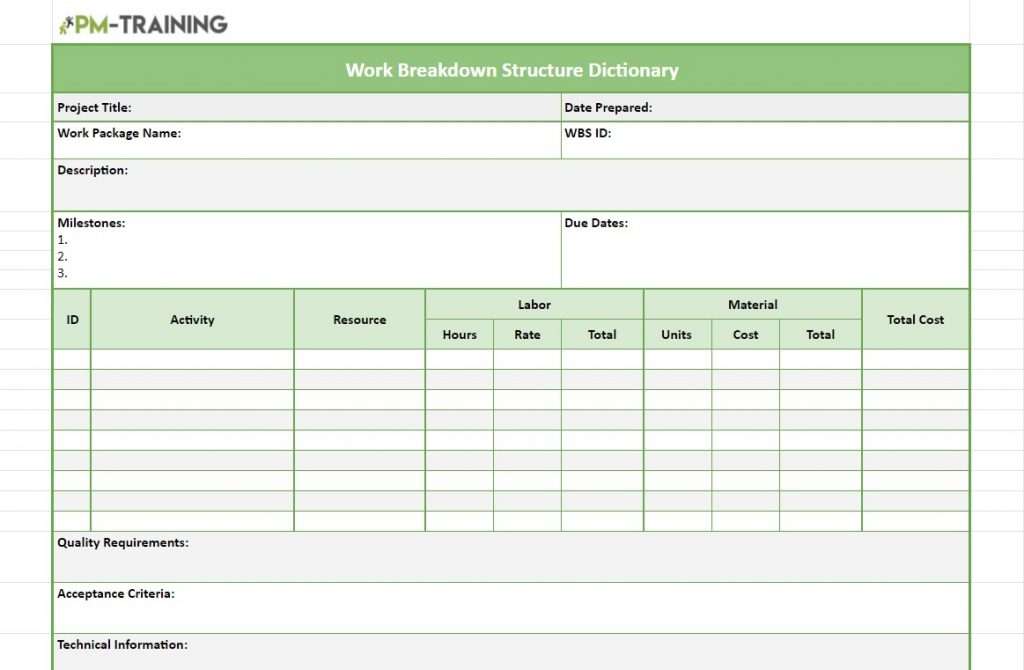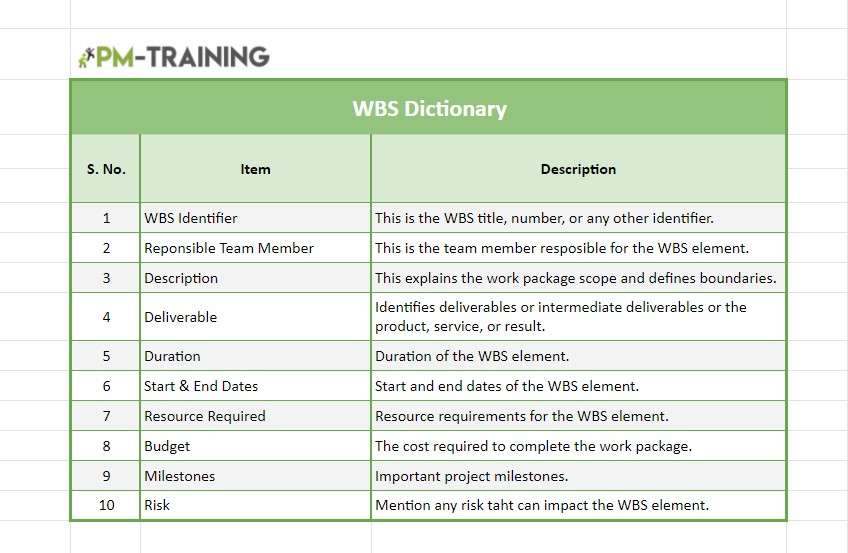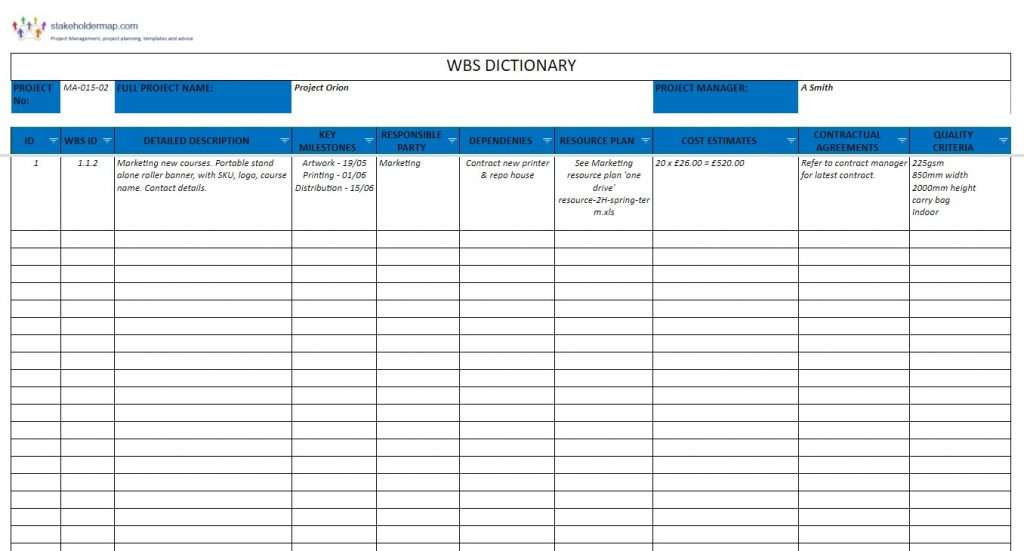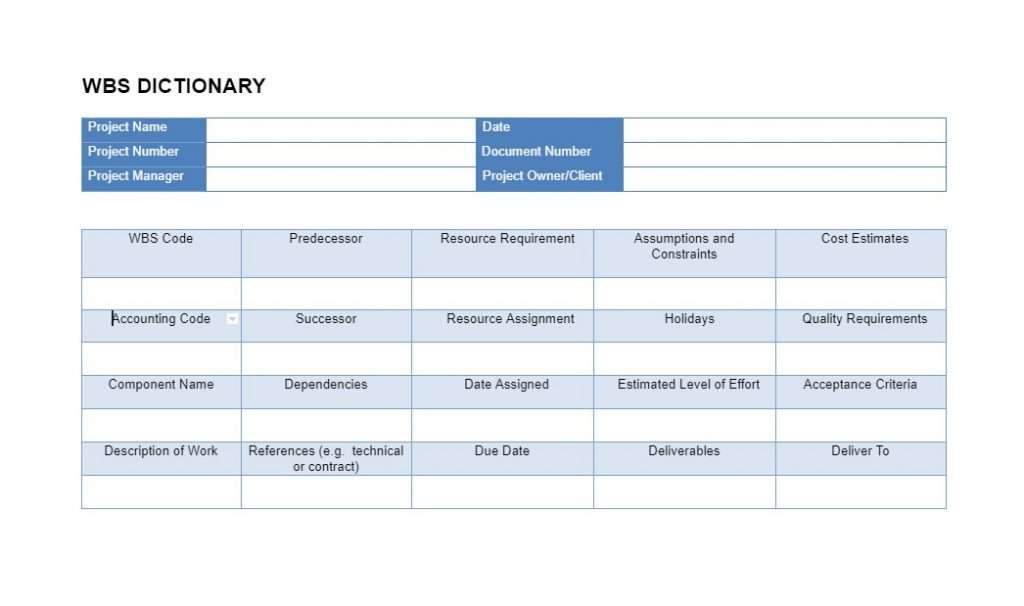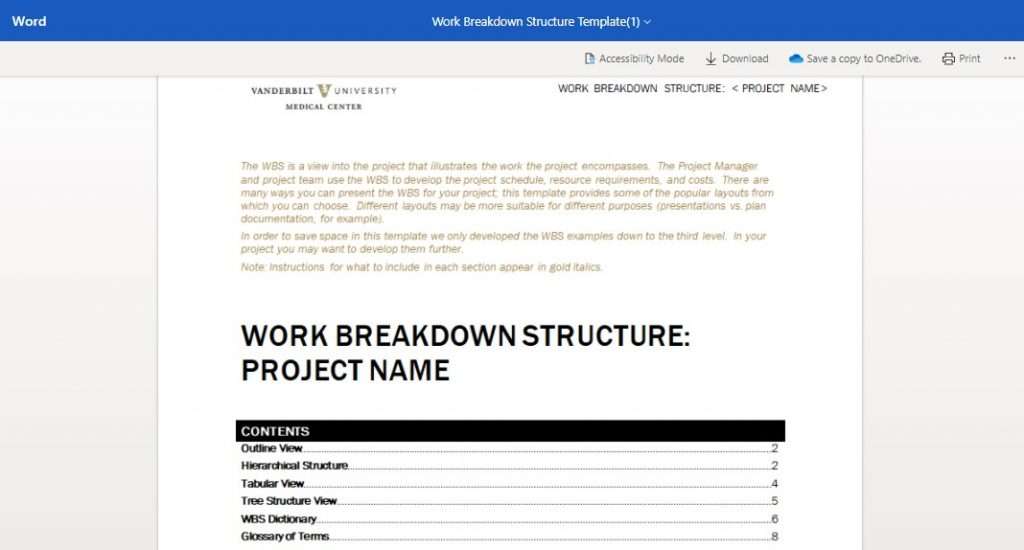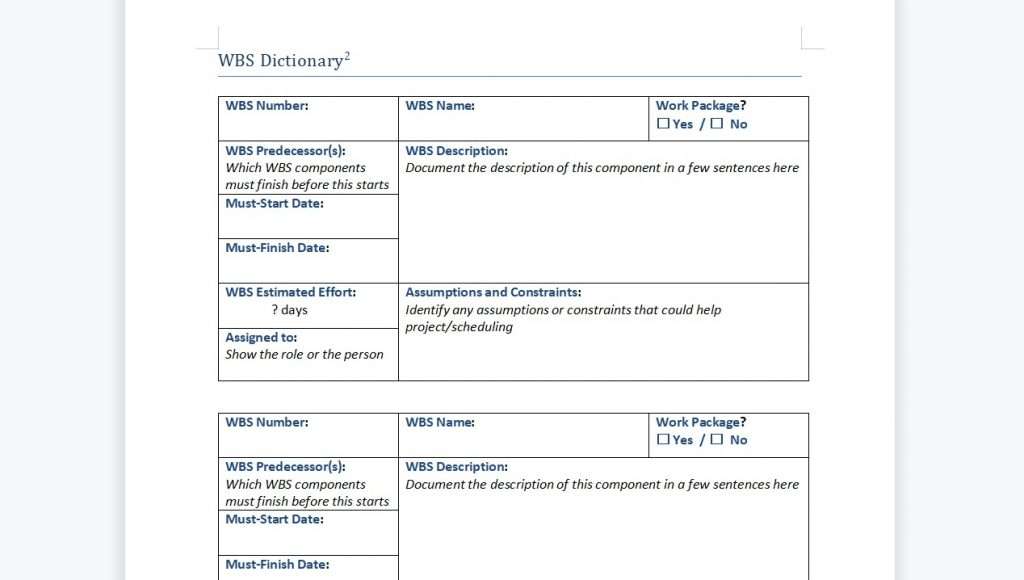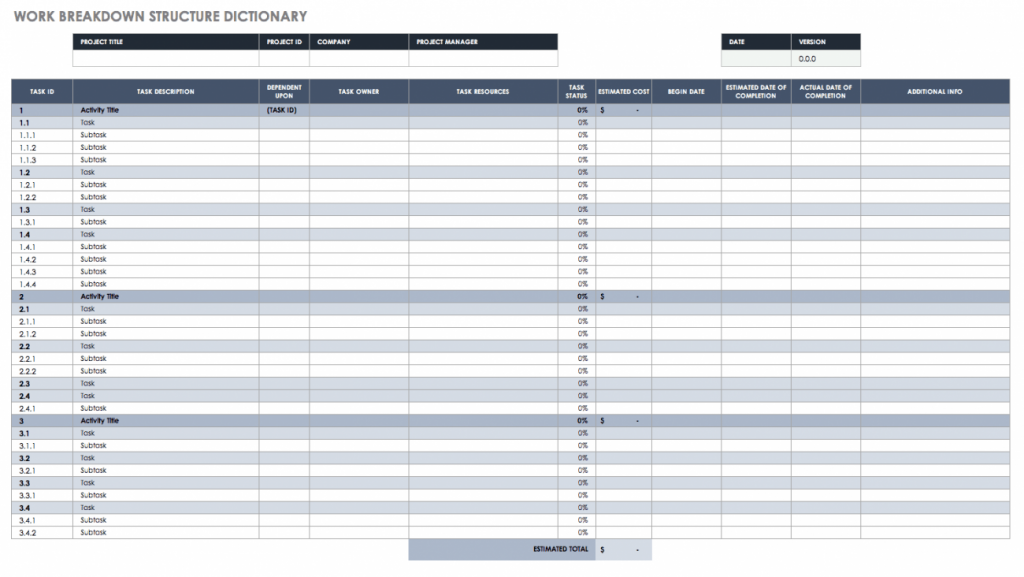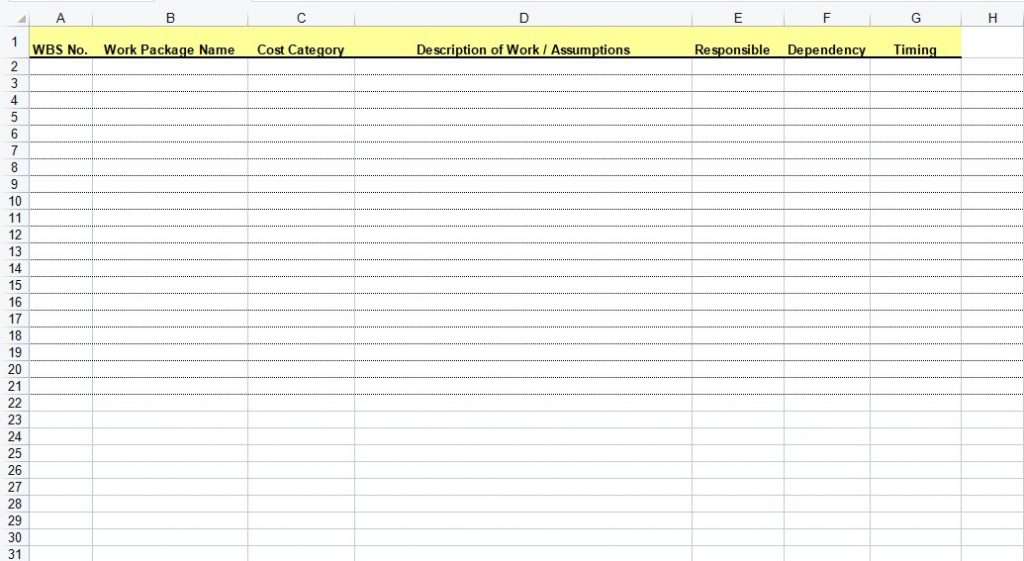The Work Breakdown Structure Dictionary, is a hierarchical decomposition of the work executed by the project team to accomplish the project objectives and create the required deliverables. It should define all of the elements within the WBS so you can consistently and unambiguously reference them in every communication throughout the project.
- Project Management WBS
- Creating and Maintaining a WBS dictionary
- Extended WBS Dictionary
- WBS dictionary template Excel vs Google Sheets
- WBS Dictionary template Word vs Google Docs
- WBS Dictionary Microsoft Word Templates
- WBS Dictionary Microsoft Excel Templates
- Work Package vs Planning Package
- WBS Dictionary FAQs
Project Management WBS
The Project Management Body of Knowledge (PMBOK) guides managing projects. It was written and published by the Project Management Institute (PMI). According to PMI, The purpose of the PMBOK is not to supply details for project managers but rather to provide guidance on how project managers should direct their personal development and then apply it in practice. But how is it related to the WBS?

As previously defined, the Work Breakdown Structure is a deliverable-oriented hierarchical decomposition of the total scope of work to be executed by the project team to produce the project’s desired outcomes. The WBS is a critical input to several Project Management processes such as Cost Management, Scheduling, Risk Management, and Quality Assurance that assist in achieving project objectives.
The WBS dictionary is a document that provides detailed deliverable, activity, and scheduling information about each component in the WBS. The WBS dictionary is a document that supports the WBS. Most of the information included in the WBS dictionary is created by other processes and added to this document at a later stage.
PMBOK 5.4.3.1
The Project Management Body of Knowledge (PMBOK) comprises numerous knowledge areas. Several processes include a Work Breakdown Structure (WBS) within these knowledge areas. The first thing to understand about how maintaining a wbs dictionary works. The PMBOK doesn’t dictate what your project should look like, but it does offer some guidance on good practices for laying out your work.
Creating and Maintaining a WBS dictionary
A work breakdown structure ( is a document that lists terms commonly used in a project management methodology, which organizes information about the tasks that create a product or deliver a service. The dictionary may cover a range of areas, such as building construction, IT development, and training & development. For example, building construction: standard definitions include the distance between two floors or the separation between external and internal wall surfaces.
If a team member were to use one of these words during their daily activities but could not find it in their relevant project documentation, they would need to contact another team member for clarification. Using WBS dictionaries reduces misunderstandings by providing additional context. This increases collaboration throughout projects, allows participants to spot errors more quickly, lowers rework, and helps reduce costs.
Another way of thinking about a dictionary is like an alphabetical index – it offers extra information on specific topics when you look up those topics in your primary resource (your Work Breakdown Structure). It acts as a cross-reference tool, ensuring you have all of your information in place.
A typical WBS-dictionary contains the following: Facilities Management Software features, enhanced data security techniques to safeguard customer data, employee data, and organizational content from hackers through its built-in firewalls. Safe processes are adopted to prevent malicious software from embedding into our systems through innovative anti-virus software updates provided free for every client.
Decomposition Technique
It is difficult to formulate a WBS in most projects without breaking it down into smaller tasks. The main aim of decomposition is to simplify and create a logical grouping of tasks that people can easily understand. There are various methods for breaking down or decomposing work into more minor manageable activities or work packages. While all these methods are equally effective, we will discuss in detail just one way – The decomposition Technique – which is very simple to understand and implement.
First, start with an understanding of what work packages are. In short, they’re tasks that can be completed and broken down into smaller pieces or sub-tasks that lead up to achieving an outcome. This is part of defining scope process in project plan.
When you create one, you don’t need to do it on paper; many project management software programs like MS Project and SmartDraw will allow you to create a WBS within them.
Secondly, once you understand what work packages are, it’s time to create your first one.
To do that, think about your outcome – it should be something that represents your big picture.
Next, break down each part into smaller and smaller pieces until you’ve created your list of actionable items. The benefit here is that if anything goes wrong or changes during implementation, you can go back up and adjust your list. This keeps things flexible for any possible scenario.
Once this is done, you can use your new list of actionable items and assign owners and resources. This way, you can ensure that everything has been adequately accounted for no matter what happens along the way.
With your new work package in place and assigned, you’re ready to move on to implementation. If anything unexpected comes up along the way or something needs adjustment, go back up one level in your hierarchy and adjust as needed.
Extended WBS Dictionary
While working on projects, it’s vital to break down each task into manageable steps. This helps ensure that all team members are aware of their responsibilities and that there is a means to check progress at each step of the way. They also make it easier to assign team members specific tasks and can even help you predict how long it will take to complete certain portions of the project.
A WBS dictionary should include the following list of items:
- Code of account identifier:
A code that uniquely identifies each account defines project or program cost and revenue elements. This identifier should be unique within a single project or program and reused across projects or programs. Each business unit must ensure that different projects don’t use conflicting identifiers. - Description of work:
Work breakdown structure (WBS) templates help break down tasks into smaller manageable chunks in any project management software. Projects can be broken down into two parts: activities and deliverables. Charts are used to understand how much time and effort is required to complete an action or deliverable. - Assumptions and constraints:
When creating a work breakdown structure, you need to define any assumptions or constraints that will guide your project. They help shape your WBS components, which in turn help prioritize tasks for your project plan. It’s often easiest to make assumptions first because they’re easier to identify than constraints. - Responsible organization:
This organization provides resources and serves as a sponsor for executing all project work. This role may be played by individuals, an external organization, or another element of your company. Still, you cannot assign a specific individual to play two roles on the same scope level. - Schedule milestones:
Milestones help ensure that you’re sticking to budget and meeting deadlines. These projects can take many forms, such as creating an outline for your new product or taking specific steps toward funding. It’s critical to monitor them to make sure you’re on track and deviate from your plan if necessary. - Associated schedule activities:
Writing out activities and dates takes time. Remember to include everything you might need down the road, such as approvals, tasks, or risks. If you’re missing information on your schedule, be sure to add it so you can have an accurate representation of what you need to complete your project successfully. - Resources required:
You have to ensure that all resources involved in performing a work package are identified. This includes both tangible resources such as materials and equipment and intangible resources such as staff time. It’s essential to have information about any specialized training required for each work package. - Cost estimates:
It’s not uncommon for organizations to run into challenges when estimating how much it will cost to complete a work package. In some cases, you may not have access to accurate information about past outlays on similar work; hence it can be challenging to develop a precise cost estimate. - Quality requirements:
The quality requirements section of a work breakdown structure is known as quality levels. It includes details like what characteristics and specifications will be used to judge whether each task was successful or not. If you’re tasked with writing an expert-level informational piece, your final product must meet specific criteria. - Acceptance criteria:
These are used to determine if an item has been satisfactorily completed. Commonly, acceptance criteria include functional and design test descriptions, performance tests, security tests, and other special tests. You should note that acceptance criteria cannot be too detailed because they would take too long to test for every little thing. - Technical references:
Work breakdown structure is that it’s an object-by-object representation of your project. Each deliverable from your project needs to be assigned one or more codes. These codes are part of what makes up your WBS dictionary; they define everything associated with any particular deliverable, such as quantity, cost, and duration. - Agreement information:
This is a detailed overview of your arrangement with your client, which includes details that you and your client discussed but didn’t make into any contract or written agreement. This should include time frames for completion, the cost for services, etc., often called responsibility definitions or project organization charts.
WBS dictionary template Excel vs Google Sheets
Choosing between Google Sheets or Excel for your business is simple. Both are powerful tools that you can use as part of your workflow to create project management templates, streamline workflows, and gain visibility into projects. But which one is right for you? In today’s post, we’ll compare Google Sheets vs. Excel to help you decide which tool best fits your needs.
Google Sheets is more simple than Excel, which has a large menu and many functions and features.
The Excel sheet is the better application to use due to its more advantages compared to Google sheets.
WBS Dictionary template Word vs Google Docs
In conclusion, Google Docs is the best to use as it offers more compatible and regular options, file compatibility and is easy and free to use. Work Breakdown Structure(WBS) is a hierarchical decomposition of the work to be executed by the project team to accomplish the project objectives and create the required deliverables. The WBS-dictionary should define all of the elements within the WBS so they can be consistently and unambiguously referenced in every communication throughout the project.
WBS Dictionary Microsoft Word Templates
WBS Dictionary Microsoft Excel Templates
Work Package vs Planning Package
Work Package: The work defined at the lowest level of the work breakdown structure for which cost and duration are estimated and managed.
Planning Package: A work breakdown structure component below the control account with known work content but without detailed schedule activities.
While some organizations may use these terms interchangeably, we would like to distinguish between work and planning packages. Firstly, a work package refers to a deliverable or task that can be completed in an organization, while a planning package refers to items needed to complete its functions.
For example, if you were developing software for your business and had a list of program features that needed to be added, each component could constitute a work package. If you then created a spreadsheet outlining how much it costs to develop each element and when you could begin developing each one, you would make a planning package to outline how your company was going to get all those features designed over time.
These are both closely related elements of a Work Breakdown Structure (WBS) in that they outline project tasks, but a work package is one element of a task, while a planning package contains several. They relate in that your organization would need a planning package, which includes work packages, to complete its tasks. In other words, you can’t build anything without a plan, which is what a planning package provides.
Another way to look at it is that your work packages would be similar to parts on an airplane; all those components must fit together for your plane to fly, but each one doesn’t have its engine. In contrast, planning packages are like engines that keep your whole organization running efficiently.
An effective planning package would also help to ensure that resources such as people, materials, and money are available throughout a project. Therefore, if you create a dictionary for each of your projects, you can easily reference them. This will help ensure that your organization’s planning packages line up with its work packages, helping ensure that you are using time wisely when tracking project tasks.
WBS Dictionary FAQs
How do you create a WBS dictionary?
While there is no standard format for a WBS-dictionary, the following steps constitute a common thread that runs through all of them: Identify item, describe it, note assumptions, assign owner, set milestone, make a schedule, list resources, calculate the cost, define quality, know acceptance criteria, collect technical references and finally settle agreements.
What should be in a WBS dictionary?
A WBS dictionary should include all abbreviations, acronyms, and definitions for each deliverable. It’s a valuable tool to keep communication clear and consistent within a project.
Is WBS dictionary necessary?
It is necessary because it is an add-on to your WBS example that provides more information about each component and its objective is to give more context to the WBS and improve its usefulness.
What is WBS dictionary in PMP?
It is a deliverable-oriented hierarchical decomposition of project activities. A WBS dictionary contains information on all project deliverables and helps in proper documentation of project deliverables.
How do I create a WBS structure in Word?
An organized WBS will help you keep your entire project on track. You can create a WBS in any spreadsheet program, such as Microsoft Excel or Numbers.

